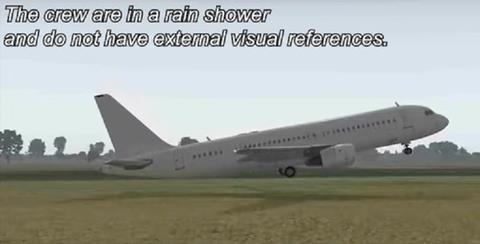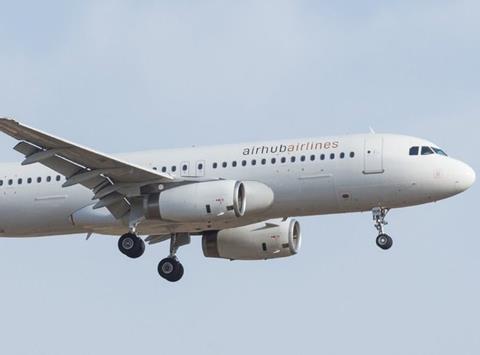French investigation authority BEA believes the prevalence of ILS approaches has obscured an underlying vulnerability of aircraft to the risk of terrain collision arising from incorrect altimeter pressure settings.
BEA made the remarks following its inquiry into a serious incident in which an Airbus A320 descended to just 6ft above ground during a low-visibility approach to Paris Charles de Gaulle’s runway 27R.
The ILS was not operational on the day of the incident, 23 May 2022, and the Airhub aircraft (9H-EMU) was conducting a satellite-based approach with barometric vertical guidance.
But BEA found the pilots had set the altimeter reference to 1011mb instead of 1001mb, after being given an incorrect QNH pressure reading by an air traffic controller. This resulted in the jet’s flying a descent path which was 280ft below the required profile.
Although this triggered a minimum safe altitude warning in the control tower, the controller took 9s to inform the crew – by which time the jet was 122ft above ground – and then used incorrect phraseology. The crew did not hear this call, and continued to descend.
BEA says the approach lights had not been switched on, and heavy rain meant the windshield wipers were operating at maximum speed.

After passing what they believed to be the decision height – but with the jet actually much lower, just 52ft above ground – the pilots initiated a go-around, because they had no visual contact with the runway.
The aircraft descended to 6ft, while 0.9nm from the threshold, before climbing away.
There was no ground-proximity warning, says BEA, because conditions to trigger basic protection modes were not met on the particular terrain-awareness system fitted to the jet.
“The crew indicated that they had not been aware of [their] proximity with the ground,” the inquiry adds.
BEA says the aircraft landed safely after a second approach, despite still having a mis-set altimeter, because the runway lights were switched on and the crew was able to establish a visual reference.
It points out that a 10mb error in altimeter setting is “one of the most frequent” mistakes and one that poses a threat, given that decision heights associated with some procedures can be as low as 250ft – meaning a ground collision could occur before the decision altitude has been displayed to the pilots.
BEA says the terrain-collision risk from a mis-set altimeter for barometric approaches, despite being “known for decades”, has not been taken sufficiently into account by the international aviation community.
It postulates that this underestimation of risk results from the development of ILS approaches, the vertical profiles of which are “not affected” by incorrect altimeter settings.
“Widespread use of ILS approaches probably helped to mask this threat and its consequences for a long time,” says BEA.
Although satellite approaches with barometric vertical guidance have been introduced to replace non-precision approaches, it adds, they have “not led the aviation community to question the impact on safety levels”.
The A320 incident at Charles de Gaulle has revealed the vulnerabilities of aircraft to such situations.

Crew operating procedures at the time, says the inquiry, did not particularly emphasise the importance of correct altimeter settings. The crew read back the incorrect pressure setting of 1011mb, and did not confirm this figure with another source of information – no operating procedure required such a check.
BEA says the aircraft did not have a system to detect a mis-set altimeter, and certification requirements do not demand such equipment.
The Charles de Gaulle air traffic tower did not have a system to alert controllers to a mis-set altimeter. European regulations do not require such systems, the inquiry says, and no tower or approach centre in France is fitted with one.
BEA also states that international regulations on air-ground communications only require the QNH pressure setting to be provided by the automatic terminal information service and during the first altitude clearance below transition level.
“No further reminder of the QNH is required once it has been provided previously, regardless of the type of approach procedure carried out, even for barometric approach operations,” it adds.
Although the crew carried out altitude-distance crosschecks for the approach, these would not have picked up the inconsistency of a wrongly-set altimeter.
“The instruments available to the crew did not enable them to identify the incorrect altimeter setting or the incorrect vertical profile,” says BEA. “On the contrary, they rather reinforced the crew’s belief that they were on the correct vertical profile.”
Instrument approach design and execution, air traffic controller processes, on-board and ground equipment are not sufficiently robust to deal with the threat, it states: “The hypothesis that current training, procedures and systems are sufficient to limit this risk is not true.”
Airhub took preventative measures after the Paris incident, underlining the importance of QNH pressure settings, and implementing flight-data analysis procedures to identify mis-set altimeter events.
French air navigation service DSNA published provisional directives requiring tower controllers to expand the number of times QNH pressure readings are transmitted to pilots conducting certain approaches, and to require systematic execution of a go-around in the event of a minimum safe altitude warning.





























